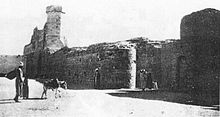Khan Yunis massacre
| Khan Yunis killings | |
|---|---|
| Part of the Suez Crisis | |

Caravanserai of Khan Yunis, 1930s
|
|
| Location | Khan Yunis, Gaza Strip |
| Date | 3 November 1956 |
| Target | Male Arab villagers Suspected members of the Palestinian fedayeen |
|
Attack type
|
Massacre |
| Deaths | ≈275+ |
| Perpetrators | Israel Defense Forces |
The Khan Yunis massacre took place on 3 November 1956 in the Palestinian town of Khan Yunis and the nearby refugee camp of the same name in the Gaza Strip during the Suez Crisis.
According to Benny Morris, during an Israel Defense Forces operation to reopen the Egyptian-blockaded Straits of Tiran, Israeli soldiers shot two hundred Palestinians in Khan Yunis and Rafah.According to Noam Chomsky's The Fateful Triangle, citing Donald Neff, 275 Palestinians were killed in a brutal house-to-house search for Fedayeen (while a further 111 were reportedly killed in Rafah).
According to Joe Sacco's graphic novel (Footnotes in Gaza ), Israeli soldiers shot some Palestinian men in their homes and lined up others and executed them. Israeli authorities claim IDF soldiers ran into local militants and a battle erupted.
In 1956 Egyptian President Gamal Abdel Nasser decided to nationalize the Suez Canal, an important waterway that allowed trade to flow to and from Mediterranean with the Indian Ocean, via the Red Sea. In a secret meeting at Sèvres on October 24, Britain, France and Israel agreed to launch a three-pronged offensive against Egypt. The attack began with an Israeli strike on Egyptian positions in the Sinai Peninsula on October 29. A day afterwards, Britain and France served an ultimatum on both Israel and Egypt, which was to function as a pretext for the subsequent operation by both powers to intervene and protect the Suez Canal. Both the United States and the Soviet Union demanded on October 30 that hostilities cease and that Israel withdraw its forces back to the armistice line. The day after, French naval forces bombarded Rafah, while the RAF made bombing raids on Egyptian airfields. Israel claimed it had conquered Rafah by November 1, and began shelling the Gaza Strip itself. Given the exercise of their veto rights in the UN Security Council by France and Britain, the two great powers were forced to obtain a resolution to that effect before the General Assembly, which duly passed a ceasefire motion on November 2, the same day that Egypt lost control of the Sinai peninsula. and incursions into Egyptian-occupied Gaza via the city of Rafah. In the early hours of that day the IDF broadcast that it knew of the identities of the fedayeen and would punish them for raiding Israel and that the civilian population would be held collectively responsible for such attacks. As a result, around 1,500 fedayeen fled the Strip with relatives for sanctuary the West Bank, to Hebron and other places, or by skiffs across to Egypt. After killing or capturing all hostile militants in the latter two population centers, forces from the two ends of the Strip met in Khan Yunis on November 3. As opposed to the swift surrender of Egyptian forces in Gaza, the garrison in Khan Yunis under the command of General Yusuf al-Agrudi put up stiff resistance. Israel replied by bombing raids and artillery shelling on the town, which exacted heavy losses in civilian lives, and troops accompanied by an armoured column took the town on November 3.
...
Wikipedia
